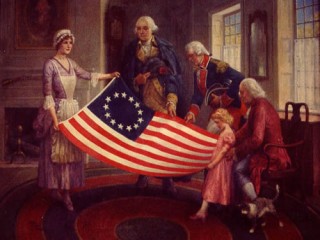
Betsy Ross biography
Date of birth : 1752-01-01
Date of death : 1836-01-30
Birthplace : Philadelphia, Pennsylvania, U.S.
Nationality : American
Category : Famous Figures
Last modified : 2011-01-18
Credited as : Made the first American flag, ,
Although the evidence is not solid, most historians point to upholsterer Betsy Ross (1752-1836) as the woman who sewed the first U.S. flag.
On June 14, 1777, the Continental Congress, on a motion from John Adams, adopted the stars and stripes as the national flag. History leaves its students with very few clues as to who designed and created the original flag, but it has been long attributed to the Philadelphia seamstress and upholsterer Betsy Ross. So widely accepted is the story of this legendary flagmaker, the United States government issued a commemorative postage stamp in 1952 in celebration of the two hundredth anniversary of her birth.
Elizabeth Griscom was the eighth of 17 children born to Samuel and Rebecca Griscom. Her father operated a building business, which had been established by her great-grandfather Andrew Griscom, who had emigrated from England in 1680. Raised and educated as a Quaker, she was disowned by the Quaker church, the Society of Friends, in 1773 when she eloped to Gloucester, New Jersey, to marry John Ross, an Episcopalian.
Ross and her husband returned to Philadelphia, where they opened an upholstery and sewing shop on Arch Street, which also served as their home. John, a member of the state militia, was killed three years later in an explosion while on guard duty. After the death of her husband, Betsy continued the day-to-day operations of the shop.
On June 15, 1777, Ross married Captain Joseph Ashburn, at Old Swedes' Church. Together they had two daughters. As with Ross's previous husband, Ashburn's military career once again made her a widow. The first mate of the brigantine Patty, he was captured at sea by the British Navy. He died on March 3, 1782, in the Old Mill Prison, Plymouth, England.
The news of her husband's death was brought to Ross by John Claypoole, a lifelong friend of both Ross and Ashburn. This friendship quickly grew into more, and the two were married May 8, 1783. Together, they continued to run the upholstery shop. Returning to her Quaker roots, Betsy and her husband joined the Society of Free Quakers. Before he died in 1817, he and Ross had five daughters.
After her third husband's death, Ross lived the remainder of her life with one of her daughters and continued to work in the shop until 1827, when she turned it over to her daughter. Upon her death on January 30, 1836, she was buried in Mount Moriah Cemetery, Philadelphia. The house where she purportedly made the flag was marked as a historical landmark in 1887.
There is very little evidence to support the story that Ross was the creator of the original flag. The story of her contribution to the design and creation of the first flag of the United States was first put forth by her grandson, William Canby, in March of 1870 before a meeting of the Historical Society of Pennsylvania. He claims that as an 11-year-old boy, his grandmother told him of her involvement with the stars and stripes while on her deathbed. According to Who Was Who in the American Revolution, the legend stated: "(George) Washington, (George) Ross, and Robert Morris came to Mrs. Ross's house in June 1776 and asked her to make a flag for the new country that was on the verge of declaring its independence. She suggested a design to Washington, he made a rough pencil sketch on the basis of it, and she there upon made the famous flag in her back parlor. She is supposed also to have suggested the use of the five-rather than the six-pointed star chosen by Washington."
Although there is no written record to support this story, there is ample evidence, in the form of receipts, that she made numerous flags for the Pennsylvania State Navy, and many efforts to refute the legend have failed. The millions of members of the Betsy Ross Memorial Association would have one accept the story as fact, but until further evidence is revealed, it cannot be either proved or disproved.
















